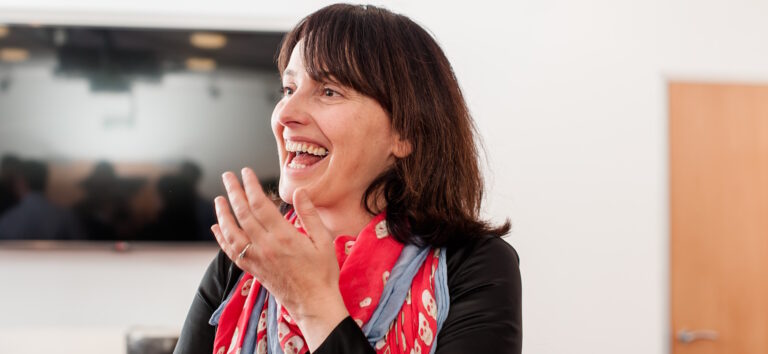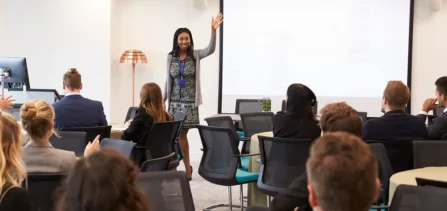
How To Use Body Language To Enhance Your Presentation Skills
How you physically hold and carry yourself makes a huge difference in how your audience receives your words.
Improve Your Presentation Body Language
As a manager, you know that mastering presentation skills is critical for effectively communicating ideas, motivating your team, and projecting leadership presence. But even if your message is compelling, poor body language can undermine your talk’s impact.
How you physically hold and carry yourself makes a huge difference in how your audience receives your words. Simple tweaks like standing with open posture, using natural hand gestures, maintaining eye contact, and having expressive facial reactions can dramatically boost your ability to captivate and connect with any crowd.
But how can you use all the tips to improve your next presentation?
In this guide, we’ll help you understand all the small tweaks you can do to improve your presentation style. From building a strong stage presence to making sure that your audience doesn’t doze off, you’ll be able to become a speaker who naturally commands attention and gains trust.
So, let’s see how you can become a speaker that not only informs but also inspires.
Key Components of Effective Body Language in Presentations
Posture – Conveying Confidence and Authority
Proper posture is crucial for projecting confidence and professionalism while presenting. Stand tall with your shoulders comfortably back and down to achieve an open, grounded stance. Distribute your weight evenly on both feet, positioned shoulder-width apart in a power pose. This occupies space and subconsciously signals assurance and leadership capability. Avoid closed-off postures like crossed arms and legs, which telegraph discomfort or aloofness. Train yourself to stand upright often outside of presentations, as posture habits inform body language cues.
Keep your chin parallel to the floor and your head upright. This levels your gaze naturally to readily meet the audience’s eyes and establish an engaging connection. Periodically roll your shoulders back to keep your chest open if needed. Use torso twists to limber up before taking the stage. Stand with authority by clasping hands behind your lower back. Small posture adjustments like these will instantly lend you greater gravitas.
Hand Gestures – Adding Emphasis and Clarity
Hand motions are a powerful tool to punctuate words and underscore meaning, so use them with deliberate purpose. Open palm gestures fluidly direct the audience’s gaze, highlighting key points without unnecessary flourish. Sweeping hand motions also reinforce ideas spatially and describe size and shape. Avoid overuse of gestures which distract. Keep hand motions above the sternum where the audience can readily see them.
Prevent anxious habits like wringing hands or touching your face. Instead, drill smooth motions originating from the core that emphasise ideas. Calibrate hand gestures to your message’s tone using palm orientation, speed, size and range appropriate to each point. Well-executed hand motions timed to accent important content, clarify the presentation and amplify impact. But use sparingly, only when meaning is enhanced.
Practical Application in Presentations
Integrating Body Language into Presentation Preparation
When preparing your presentation, consciously plan how physical presence will complement the narrative. Script instances to stand tall to convey confidence at key points. Note when expansive gestures could underscore important ideas. Plan for natural eye contact with participants throughout the room. Identify areas where facial expressions might heighten engagement.
Practice fluid transitions between postures and gestures. Appropriately time movements and gestures to sync with speech patterns. Review the video to confirm body language aligns with your intentions. Refine through repetition to eliminate distracting motions and polish physical delivery.
Dynamic Body Language During Live Presentations
While presenting, let body language emerge naturally from the content while adhering to openness, purpose and confidence principles. Avoid remaining static, or you may disengage the audience. Move with an intention to occupy the stage using diagonal crossing patterns. Pivot your torso and stance when transitioning.
Continually scan the room, making eye contact. Use sustained gestures more dynamically when speaking passionately to boost energy and enthusiasm. Allow facial expressions to reflect the speech’s emotion. Respond physically to audience reactions. Adjust pacing, gestures, and proximity as needed to recapture wandering attention. An authentic, dynamic physical presence will keep your audience engaged.
Simple Exercises to Enhance Body Language Skills
Daily Routines for Better Posture
Building better posture requires daily practice. Set reminders so you periodically stand tall and roll your shoulders back to open your chest. Stretches like overhead reaches target tight muscles that pull shoulders forward. Yoga poses that extend the spine help counteract slouching. Perform exercises like planks to build core strength for a balanced stance.
Use visualisation techniques daily, too – imagine balancing a book atop your head as you walk. Adopt grounded public speaking stances like hands clasped behind your back. The more upright postures become an ingrained habit, the more poised and confident you’ll appear when presenting.
Practice Drills for Effective Hand Gestures
Avoid small, jittery hand motions – instead, drill broad, purposeful gestures that fluidly originate from your core. Rehearse synchronised motions in front of a mirror, timed to match speech patterns. Mark words for emphasis gestures on your script or teleprompter.
Vary gesture size and speed to fit the tone of your message. Watch TED talks and replicate speakers’ effective motions to expand your repertoire. With consistent practice, gestures will become a seamless way to emphasise key points and amplify your presentations.
Advanced Body Language Strategies for Presentations
Adapting Body Language for Diverse Audiences
Tailor your body language approach based on audience demographics to increase engagement:
- Research cultural norms on gestures and personal space to avoid miscommunicating with international attendees.
- Adjust formality appropriately for executives versus new hires.
- Adjust gestures to be visible and expressions to be exaggerated if presenting to an audience with visual or hearing impairments. Use simplicity, repetition, and descriptive language.
- Make body language inclusive by scanning the full room with eye contact, not just focusing on leadership.
- Naturally pace stance and gestures to resonate across generations.
Responsive, adaptive physical presence fosters audience connection.
Context-Specific Body Language Techniques
Adjust techniques based on the presentation context. Subtle, confined gestures suit lecterns, while expansive motions engage stage audiences. Convey passion facially and physically for motivational speeches. A CEO may feature formal postures, while an engineer can relax formality for tech demos. Conversational gestures engage small groups.
For video conferences, look into the camera when speaking, then pan side-to-side to show attentiveness. Lean slightly forward on intensifying words. Exaggerate nods, smiles and frowns for clarity onscreen. Contextual mastery makes every talk more effective.
Body Language in Digital Presentation Platforms
Challenges and Strategies for Virtual Presentations
Presenting through video conferencing poses body language challenges:
- Limited mobility due to being seated and on camera can make presentations feel static and disengaged.
- Distance from the camera may mean facial expressions and subtle gestures get lost.
- Lack of audience visual feedback is difficult.
However, some strategic tweaks can help amplify your virtual presence:
- Stand and gesture when possible to emulate live delivery. Incorporate periodic movement.
- Position the camera at eye level and look directly into it to simulate eye contact.
- Use visual aids like slides or images behind you for audience focus.
- Request audience webcams be on for virtual nods, smiles and eye contact.
Effective Use of Body Language in Video Conferencing
When presenting via video chat platforms:
- Properly position the camera at eye level to emulate eye contact.
- Look into the camera when speaking, then pan to side screens to view participants’ faces.
- Project confidence through purposeful posture and avoid distracting fidgets off-screen.
- Convey energy by varying pace, emphasis gestures, and vocal delivery.
- Use exaggerated facial expressions for clarity onscreen.
- Occasionally lean forward subtly on key points for intensified engagement.
- Send “looking to audience” visual cues before asking questions.
Proper use of virtual body language techniques makes online presentations more dynamic and impactful.
Elevate Your Presentation Skills With Impact Factory
Now armed with evidence-based techniques to amplify your body language impact, it’s time to put these tips into practice. Reflect on your upcoming presentations and identify areas needing improvement. Set goals to integrate one new technique per talk until a powerful physical presence comes naturally. Also, continue observing seasoned speakers to expand your skills repertoire.
For professionals seeking to master presentation skills beyond just body language, our Impact Factory Presentation Skills Training Course offers an intensive learning experience. The program elevates verbal delivery, content structure, audience engagement, and physical presence through hands-on sessions with expert coaches.
The course features modules dedicated to body language mastery, including stance, movement and eye contact for gravitas. However, you’ll also be able to identify your strengths, learn how to become less nervous and make your presentations more engaging.
So, whether you need to pitch ideas within the company, win over new customers, enchant stakeholders in a boardroom or talk to the public and media, you’ll become more confident and learn how to craft a presentation that allows you to reach your goals.
To learn more about our transformative presentation training, browse through our offer of courses or email enquiries@impactfactory.com. Our knowledgeable coaches provide personalised guidance to dramatically boost your public speaking capabilities.
Contact us today to amplify your presence and confidence as a presenter.
FAQs
What are soft skills for body language?
Key soft skills for mastering body language include:
- Self-awareness – recognising your natural gestures
- Empathy – reading others’ nonverbal cues
- Adaptability – adjusting body language by context
- Active listening – paying attention to others’ signals
- Authenticity – using gestures that feel natural
What are the 5 P’s of presentation skills?
The 5 P’s are a framework for excellent presentations:
- Planning – research and outline content
- Preparation – create slides, handouts, notes
- Practice – rehearse delivery out loud
- Presentation – deliver material confidently
- Post-Evaluation – review feedback afterwards
What is the 5/5/5 rule for better presentation?
The 5/5/5 rule suggests:
- 5 key points maximum per slide
- 5 words maximum per bullet point
- 5 text-heavy slides maximum in a row before visuals
This technique improves engagement by simplifying slides and varying content types.
Related Articles:
Here are more resources to help you plan your next steps:
- Presentation Skills Training – Browse through our offer to see what you can gain from the training.
- Presentation With Impact – In this course, you can find your unique presentation style and sharpen your skills to perfection. Explore what our course has to offer.
- Tips To Improve Your Presentation Skills From Industry Insiders – Learn more about small yet impactful tweaks to your next presentation so you can captivate the audience and reach your goals.
- How To Create Impactful Presentation Slides – The days with slides full of barely readable text are long gone. Explore our tips to make your slides more engaging.







